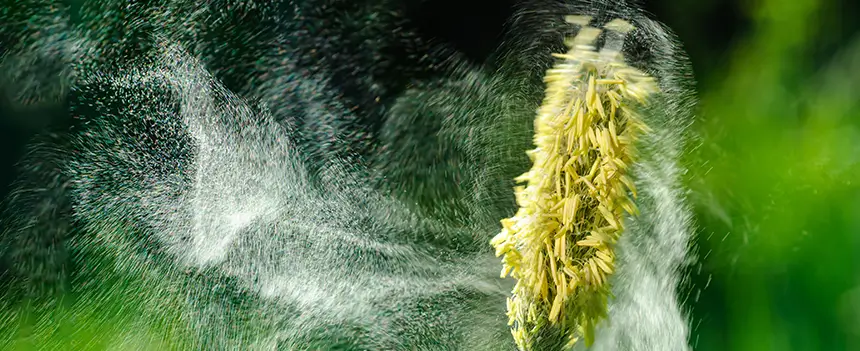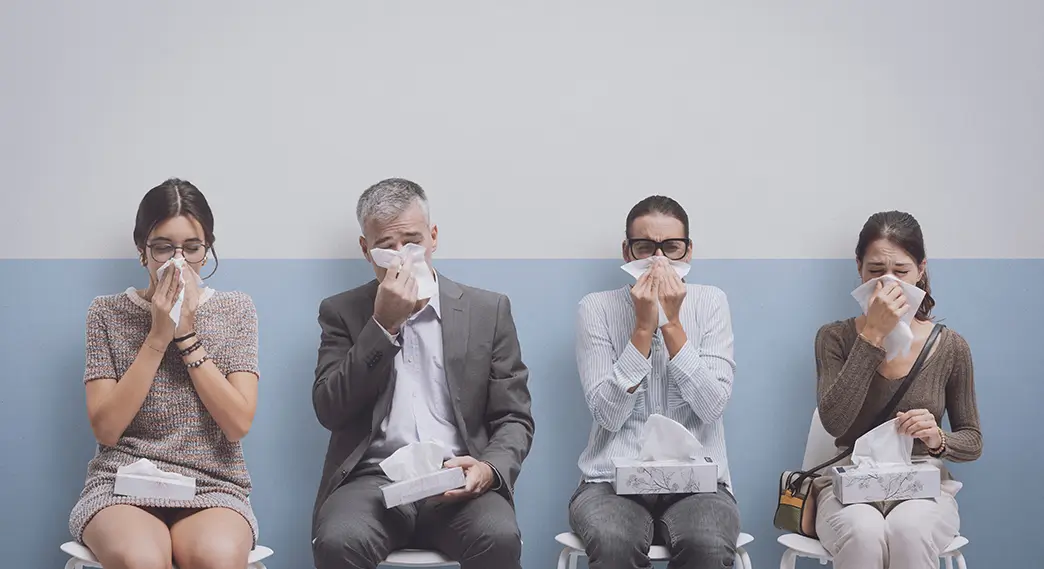
Hay Fever – The Modern Common Ailment of Pollen Allergy
Hay fever is one of the most common allergies in Western industrialized countries and seems to be spreading from generation to generation. According to the Robert Koch Institute, almost 15 percent of the German population is affected by a pollen allergy. According to the University Hospital Zurich, the rate in Switzerland is even 25 percent. Statistics and research indicate that the likelihood of developing hay fever increases due to factors such as air pollution, unhealthy lifestyle, or excessive hygiene. Moreover, there is a high probability that affected individuals will pass their allergies on to their offspring.
Contents
Contents
The allergy, which can range in impact from cold-like symptoms to allergic asthma, is triggered by the pollen of various grasses, cereals, and trees. Their pollen floats in the air as tiny particles, is inhaled, or gets into the mucous membranes of the eyes, mouth, and nose. There, they trigger an immediate reaction of the immune system. Watery eyes, a constantly runny nose, or asthma attacks can ruin the day for pollen allergy sufferers from spring to autumn. However, we are not completely defenseless against this "widespread disease". In addition to suppressing symptoms with medication, it is often possible to weaken the allergy itself through hyposensitization.

What is hay fever?
Hay fever is triggered by pollen. Pollen is a component of flower dust – it is the male genetic material used to "pollinate" female flowers. Some flowering plants rely on bees and other insects to carry their pollen from flower to flower. For allergy sufferers, the pollen that spreads exclusively by the wind is particularly problematic. To ensure their species' survival, some trees, grasses, and shrubs release millions of pollen, which float as microscopic particles in the air and can spread many hundreds of kilometers.
Not all plants bloom at the same time – for example, alder and hazel bloom as early as March, followed by birch pollen and grasses in late spring. Various grasses and herbs bloom even into the autumn. Fortunately, most pollen allergy sufferers are not allergic to all flower pollen. They only have to deal with symptoms for part of the year. Those who are stuffy all year round and also show symptoms in winter are more likely to suffer from allergic rhinitis, which can be triggered by a combination of dust, spores, animal allergens, and pollen. A pure pollen allergy occurs only seasonally.

Typical symptoms and complaints of pollen allergy
Hay fever is a type I allergy – the symptoms appear almost immediately upon contact with the allergen. Even small amounts of pollen are enough to provoke the immune system of allergy sufferers. The essentially harmless pollen is perceived as threatening substances. The overreaction of the body's defense mechanisms causes the typical symptoms of hay fever.
- Cold-like symptoms such as a stuffy or runny nose or frequent sneezing are probably the most common. If the nose runs, it does not stop quickly in severe cases.
- If the allergy affects the bronchi and lower airways, it can manifest as coughing and audible wheezing in the lungs. Severe symptoms range from shortness of breath to allergic asthma.
- Tearing and itchy eyes are also very common. They are often accompanied by noticeable redness of the conjunctiva. The urge to rub the eyes can be very strong, but doing so only intensifies the symptoms. It can be helpful to treat the eyes with a special eye wash solution to flush out allergens. Otherwise, they will be washed away with tears over time.
- Headaches, fatigue, and concentration difficulties also occur in connection with hay fever. In some people, the allergy triggers migraine-like symptoms. Sleep disturbances and increased light sensitivity of the eyes have also been associated with hay fever.
- Less commonly, a so-called angioedema occurs. This is a swelling of the skin or mucous membranes caused by fluid retention. It can be accompanied by itching and the formation of welts and eczema. Again, do not scratch, but cool the affected area. If severe angioedema occurs around the head and neck, seek medical help.
A pollen allergy can naturally become weaker over a person's life. However, it can also become stronger – especially in severe cases, late consequences such as allergic asthma can develop if the allergy remains untreated. Treatment options for hay fever are discussed further below.
Cross allergies in hay fever
Cross allergies occur when different substances trigger the same allergic reactions. These different substances are so similar that the immune system cannot distinguish between them. Pollen allergy sufferers often suffer from cross allergies, which occur in connection with fruits or nuts. For example, people allergic to apples are often also allergic to birch pollen. Cross allergies with birch also exist with nuts, almonds, peaches, and other fruits. Some vegetables, such as celery or carrots, can cause cross-reactions with herbs like mugwort or spices like pepper.
Less commonly, cross allergies occur with substances that have little or no similarity. For example, people allergic to grasses sometimes cannot tolerate peas or other legumes. In rare cases, cross-reactions with latex have been reported, triggered by allergies to fruits.
In the case of reactions to foods, it is often possible to eliminate the allergen by heating. For example, people who cannot tolerate raw apples can often consume them in the form of previously cooked applesauce or as baked apples at Christmas. However, in the case of severe food allergies, it is advisable to avoid contact with the allergen completely.

Why are more and more people getting hay fever?
Over the past decades, the number of pollen allergy sufferers in Germany and other Western industrialized nations has increased significantly, while the numbers in Eastern Europe or the Balkans have remained practically stagnant. More and more researchers are linking this increase to factors such as diet, lifestyle, or air pollution. Since city children are much more likely to develop hay fever than children who grow up in the countryside, there are likely connections with hygiene conditions and air quality.
The so-called hygiene hypothesis suggests that children whose immune systems can "get used" to various germs early on have better protection against allergies like hay fever. "Country" children come into contact with various germs much more frequently. Scientists are particularly focusing on bacteria that contain the toxin endotoxin. Endotoxins can cause fever and inflammation but are also believed to trigger immune reactions similar to those of hyposensitization against allergens. The immune system thus learns to tolerate allergens like pollen, animal proteins, or dust.
Factors such as air pollution from fine dust, exhaust gases, or smoke seem to affect the severity of allergies. In areas with high fine dust pollution, hay fever also tends to be more common. It is believed that various pollutants in the air make the mucous membranes of the airways more sensitive to allergens.

Diagnosing and treating hay fever
If you notice symptoms that indicate hay fever, it is best to consult your trusted doctor. Often, general practitioners, pediatricians, or dermatologists are also allergists and offer allergy tests in their practice. It is important to first test the exact triggers of hay fever and the severity of the immune reaction to plan further treatment.
There are various allergy tests. The prick test is often used to determine pollen allergies. This is a skin test conducted on the forearm or back of the test person. It is important to have a larger skin area available, as fields are drawn on the skin before the test. A different allergen in a neutral liquid is dropped on each field – the drop is then pierced with a sterile needle. The needle scratches the top layer of skin so that a small amount of the allergen can penetrate the tissue. The local reaction (redness, welts, etc.) indicates whether an allergy is present.
Once it is known which pollen triggers your hay fever, hyposensitization can be considered. This is a longer process in which small amounts of an allergen are regularly taken. By slowly increasing the dose, the immune system can get used to the allergen and react with a much weaker immune response. Allergies like hay fever can often be weakened to the point where they no longer pose a burden in everyday life. Hyposensitization usually takes between 12 and 24 months and is most successful when done at a young age. However, adults also have good chances of alleviating their hay fever.
Allergic symptoms can also be suppressed with medication. However, they cannot be cured with it. In the case of hay fever, drugs counteract symptoms such as the swelling of the mucous membranes. It may therefore be advisable to take medication for severe hay fever as long as the relevant pollen is flying. Always seek medical advice if you suffer from severe hay fever.



